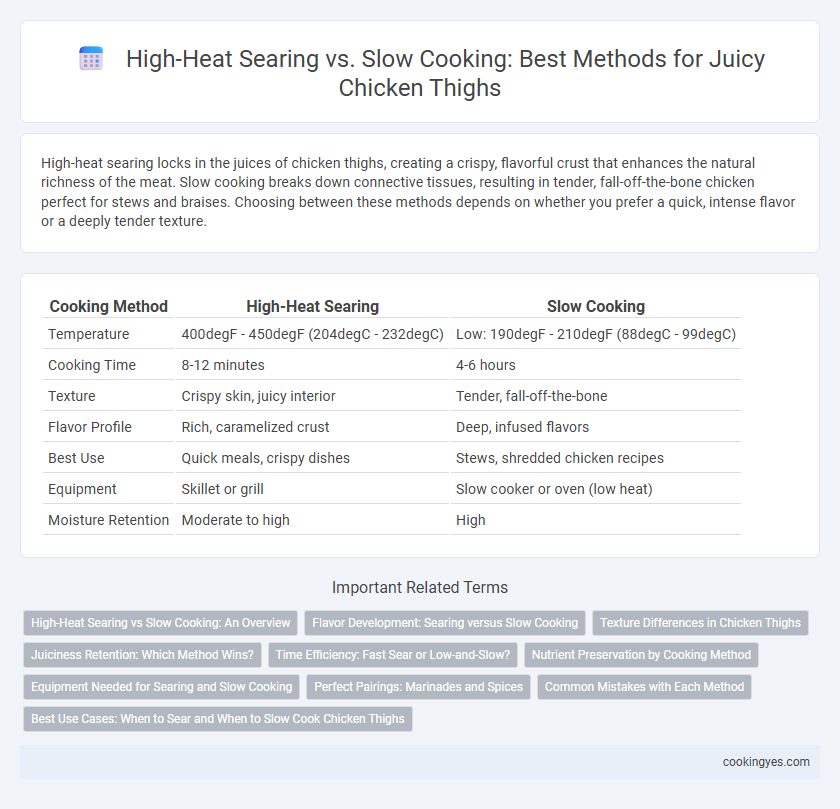High-heat searing locks in the juices of chicken thighs, creating a crispy, flavorful crust that enhances the natural richness of the meat. Slow cooking breaks down connective tissues, resulting in tender, fall-off-the-bone chicken perfect for stews and braises. Choosing between these methods depends on whether you prefer a quick, intense flavor or a deeply tender texture.
Table of Comparison
| Cooking Method | High-Heat Searing | Slow Cooking |
|---|---|---|
| Temperature | 400degF - 450degF (204degC - 232degC) | Low: 190degF - 210degF (88degC - 99degC) |
| Cooking Time | 8-12 minutes | 4-6 hours |
| Texture | Crispy skin, juicy interior | Tender, fall-off-the-bone |
| Flavor Profile | Rich, caramelized crust | Deep, infused flavors |
| Best Use | Quick meals, crispy dishes | Stews, shredded chicken recipes |
| Equipment | Skillet or grill | Slow cooker or oven (low heat) |
| Moisture Retention | Moderate to high | High |
High-Heat Searing vs Slow Cooking: An Overview
High-heat searing chicken thighs creates a crispy, golden-brown crust by rapidly caramelizing proteins and fats at temperatures above 400degF, preserving moisture and intensifying flavor. Slow cooking, typically done at 200-300degF over several hours, breaks down connective tissues, resulting in tender, juicy meat with a deeper, more uniform flavor profile. Choosing between techniques depends on desired texture; searing offers a contrast between crisp exterior and moist interior, while slow cooking yields melt-in-your-mouth softness.
Flavor Development: Searing versus Slow Cooking
High-heat searing of chicken thighs creates a Maillard reaction, which develops a rich, caramelized crust enhancing savory and umami flavors. Slow cooking breaks down collagen in the meat, resulting in tender, juicy texture while allowing deeper infusion of herbs and spices over time. Balancing searing with slow cooking techniques maximizes both robust flavor and succulent tenderness in chicken thighs.
Texture Differences in Chicken Thighs
High-heat searing creates a crispy, caramelized exterior on chicken thighs while maintaining juicy, tender meat inside, ideal for a contrasting texture experience. Slow cooking breaks down connective tissues over time, resulting in extremely tender, fall-apart chicken thighs with a uniformly soft texture. The choice between these methods depends on whether a crispy crust or melt-in-your-mouth tenderness is desired for the dish.
Juiciness Retention: Which Method Wins?
High-heat searing locks in moisture quickly by forming a protective crust on chicken thighs, minimizing juice loss during cooking. Slow cooking, while tenderizing meat over time, can cause more moisture to escape, resulting in less juicy thighs compared to searing. For optimal juiciness retention, high-heat searing followed by a brief oven finish often outperforms prolonged slow cooking.
Time Efficiency: Fast Sear or Low-and-Slow?
High-heat searing chicken thighs takes just 5 to 7 minutes, creating a crispy exterior while locking in juices quickly, making it ideal for time-efficient meals. Slow cooking involves simmering chicken thighs for 4 to 6 hours at low temperatures around 200degF, producing tender, flavorful meat but requires significant time investment. Choosing between fast sear or low-and-slow depends on whether quick preparation or deep flavor development is the priority.
Nutrient Preservation by Cooking Method
High-heat searing locks in moisture quickly while preserving protein structure and essential B vitamins in chicken thighs, preventing nutrient loss caused by prolonged exposure to heat. Slow cooking breaks down collagen, enhancing tenderness and bioavailability of certain minerals like zinc and iron but may reduce heat-sensitive vitamins such as vitamin B6. Balancing cooking methods can optimize nutrient retention while delivering flavorful and tender chicken thigh dishes.
Equipment Needed for Searing and Slow Cooking
High-heat searing of chicken thighs requires equipment such as a heavy-bottomed skillet or cast-iron pan, a stovetop burner capable of maintaining high temperatures, and tongs for flipping. Slow cooking demands a slow cooker or crockpot, adjustable temperature settings for controlled heat over several hours, and a lid to retain moisture. Proper equipment ensures optimal texture and flavor development in each cooking method.
Perfect Pairings: Marinades and Spices
High-heat searing locks in juices and creates a crispy skin on chicken thighs, ideal for marinades with bold flavors like soy sauce, garlic, and ginger that caramelize quickly. Slow cooking tenderizes the meat and allows spices such as smoked paprika, cumin, and thyme to deeply infuse, resulting in rich, savory profiles. Combining these techniques with the right marinades enhances texture and flavor, elevating chicken thighs to a gourmet experience.
Common Mistakes with Each Method
High-heat searing of chicken thighs often leads to common mistakes such as overcrowding the pan, which causes steaming instead of browning, and failing to preheat the skillet properly, resulting in uneven crust formation. Slow cooking errors include neglecting to brown the chicken beforehand, which diminishes flavor complexity, and cooking at too low a temperature, potentially leaving the meat rubbery or undercooked. Proper technique in each method ensures optimal texture, juiciness, and flavor development in chicken thighs.
Best Use Cases: When to Sear and When to Slow Cook Chicken Thighs
High-heat searing is ideal for chicken thighs when aiming to achieve a crispy, golden-brown skin and locking in juices quickly, perfect for weeknight dinners or recipes requiring a firm texture. Slow cooking chicken thighs excels in breaking down connective tissue, resulting in tender, flavorful meat suited for stews, braises, or shredded chicken dishes. Selecting between searing and slow cooking depends on desired texture and time available, with searing offering speed and crispness, while slow cooking emphasizes moisture retention and depth of flavor.
High-heat Searing vs Slow Cooking for Chicken Thighs Infographic

 cookingyes.com
cookingyes.com